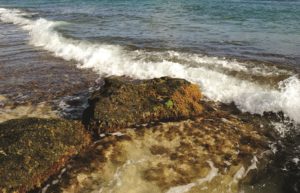The fish seem to be settling into a fairly normal summer pattern lately, unlike most of their human counterparts.
Striped bass can be found in good numbers from the Cottages at Beach Point, at the Twin Hills behind Long Point, and from Wood End to Race Point and on towards the backside ocean beaches by the Ranger Station. These fish are still on the smaller side: 25 to 27 inches, and drifting cut bait is still the most effective method.
Bluefish, which have been mostly absent for a few years in our locale, have reappeared and seem to have settled in for now. They have been in the same areas as the striped bass, and they, too, are running small: three to five pounds. Top-water swimming plugs, such as the Bomber Long A and the SP Swimmer, are working very well. Don’t forget to use a steel leader, as these toothy critters can easily bite through monofilament and braided fishing line.
Mackerel have thinned out a little in the harbor but have been replaced with copious numbers of squid. Also, those huge schools of pogies have not been seen as much as they were in the preceding couple of weeks. So, we have a little shift in what’s here and what’s not as the temperature of our waters continues to climb.
One thing that is heavily here at the moment is mung. Mung (Pylaiella) is a type of seaweed (brown algae) that is known for its ability to coat everything in comes in contact with, such as people, ropes, and animals, when it blooms close to the shore in warm water. It fouls lures as they are retrieved and is particularly bad with umbrella rigs trolled through the water.

I am hearing of some fluke being caught in places they used to be caught when they were here years ago; we even caught a couple of small ones on the Cee-Jay last week. I am going to try to do an exploratory trip for them one of these days just to see what’s around and will report back as soon as I do. If fluke were back it would be exciting news for recreational fishermen.
This is a good time to remind boaters and beach walkers that the cages you see out in the West End flats in Provincetown Harbor are shellfish farms; please be mindful of that. These men and women work hard to cultivate shellfish to sell and about the last thing they need is to have them damaged by boats or people walking about. The yellow buoys you see mark the perimeter of the area, so at high tide, when the cages are submerged, you know where they are. Treat this area the way you would treat a farm on land. You wouldn’t go zooming around a farmer’s corn field or wheat field in your car; the same principle holds true here. Don’t zoom around a shellfish bed in your boat.
There are a half dozen so fin whales hanging around Race Point, feeding on the abundant herring, sand eels, and mackerel in that area. They can easily be seen from the beach. A pair of binoculars makes the sightings even better.
It has been strangely quiet on the white shark front, as sightings have been down significantly compared to last year. Is it because our beaches are so lightly populated this summer or is it something else? This bears watching for sure, to see what’s going on out there.



